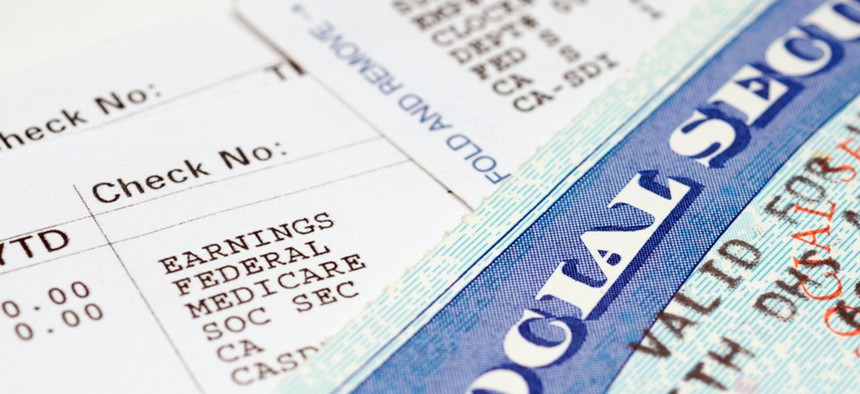
chuckstock/Shutterstock.com
Changing Stakes on Claiming Social Security
Congress puts a stop to two popular strategies for maximizing benefits.
As a result of a surprise move by Congress late last year, two popular strategies that can maximize Social Security retirement benefits are coming to an end.
The problem, according to the Social Security Administration, is that use of the strategies “allowed couples with financial means to obtain additional or enhanced benefits that Congress did not intend, and are contrary to the goals of the Social Security program.”
For now, those will turn 66 on or before May 1, 2016 (or maybe April 29 or 30--that’s yet to be determined for sure), can still file and suspend their Social Security retirement application for benefits to allow their spouse to file for spouse’s benefits while the other worker’s benefit accrues delayed credits. If you have reached full retirement age, but have not yet turned 70, you can file for benefits but then ask Social Security Administration to suspend retirement benefit payments.
But then things begin to change, in ways that are still murky. The Social Security Administration, who will be implementing the changes, has published a two-page flyer titled Bipartisan Budget Act of 2015, but it doesn’t include many details. Mary Beth Franklin, a well-known expert on Social Security, recently wrote in Investment News that all she had heard about this from SSA officials was, “our legislative and policy staffs are diligently working with Congress to analyze the intent of the legislation and update our instructions.”
Here’s what we know so far: The changes in the law mean you may have to change your plans for claiming Social Security retirement benefits if you were planning to file a “restricted application” on your spouse’s work record in order to receive delayed retirement credits on your own account. To file on your spouse’s work record, your spouse needs to file for retirement benefits, although he or she would have the option to delay the actual receipt of the benefit--a strategy known as “file and suspend.” The increase in your Social Security benefit as a result of receiving delayed retirement credits increases the earned Social Security benefits by 6 percent to 8 percent (depending on your full retirement age) for each year in which you (or your spouse) defer claiming between the ages of 66 and 70.
There’s a significant difference in the monthly amount of your Social Security retirement benefit depending on whether you file at your first eligibility at age 62, or delay to as late as age 70. The filing strategies in question require that you (or your spouse) has already reached the full retirement age. If you (or your spouse) are younger than the full retirement age, then the rules currently in effect require payment of the higher benefit that you have earned for yourself, or the one that your spouse has earned for you.
After the May 1 deadline, anyone who suspends will find that no benefits will be payable to their spouse until the person who suspended chooses to reinstate benefits by canceling the suspension or filing for benefits to start.
There’s an exception for those entitled to a widow's benefit. Here’s information on that from Social Security:
If you:
- Already receive benefits as a spouse, your benefit will automatically convert to survivors benefits after we receive the report of death.
- Are also eligible for retirement benefits (but haven't applied yet), you have an additional option. You can apply for retirement or survivors benefits now and switch to the other (higher) benefit at a later date.
- Already receive retirement benefits, you can only apply for benefits as a widow or widower if the retirement benefit you receive is less than the benefits you would receive as a survivor.
Also, if you are single and had planned to keep an “ace in the hole” by filing and suspending your own Social Security benefit so that you could choose to receive the delayed retirement benefits or choose to claim a lump sum benefit later, this strategy is also ending--I think. This part of the new law is not entirely clear, because it pertains to personal strategies that are not related to couples claiming strategies.
Here’s how it currently works: You can file for but suspend receiving your own earned benefit, but between your full retirement age and age 70, you can “turn on” your benefit and get the payments you would have received back to your full retirement age in a lump sum payment.
If you reached age 62 before 2016, then you may still have the option of filing a restricted application even if you have not yet reached your full retirement age by 2016. Once you have reached your full retirement age, but are not yet 70, you can restrict your application to your spouse’s work record and allow your own earned benefit to increase with delayed retirement credits. If you file for Social Security benefits prior to reaching your full retirement age, you will receive the higher of the benefit that you’ve earned for yourself or the benefit that your spouse (or former spouse, if qualified) has earned for you. In order to file for spousal benefits from your current spouse, they must have filed for benefits (or filed and suspended their application for benefits). Only one spouse can apply for retirement benefits and have the payments suspended.
If you were planning to use one of these strategies before the stated deadlines, you’ll be able to continue. If your benefit payments are suspended, they will start automatically the month you reach age 70. You may want to consult your financial adviser so you don't miss out during the transition. SSA should be updating its website in the near future to reflect these new rules.
(Image via chuckstock/Shutterstock.com)
NEXT STORY: New TRICARE Drug Co-Pays Take Effect







